Equipping Property Graduates for the Digital Age
Abstract
1. Introduction
- Do the skills and knowledge of property graduates meet property industry employers’ expectations in this digital age?
- What series of skills do property employers expect property graduates to possess in this digital age?
- What are the best strategies that can equip property graduates with the knowledge and skills required to excel in practice?
2. Literature Review
2.1. Essential Knowledge and Skills for the Property Industry
2.2. Gaps between Property Practice and Property Education
2.3. Initiatives for Bridging the Expectation Gaps
3. Materials and Methods
4. Results and Discussion
4.1. Profile of the Property Employers
4.2. Knowledge and Skills in the Digital Age for the Property Employers
4.3. Profiles of the Property Graduates
4.4. Knowledge and Skills in the Digital Age for Property Graduates
4.5. Differences in Perceived Importance of Knowledge and Skills between Employers and Graduates
4.6. Differences in Perceived Strategies between Employers and Graduates
5. Conclusions
Author Contributions
Funding
Institutional Review Board Statement
Informed Consent Statement
Data Availability Statement
Acknowledgments
Conflicts of Interest
References
- Giang, D.T.; Pheng, L.S. Role of construction in economic development: Review of key concepts in the past 40 years. Habitat Int. 2011, 35, 118–125. [Google Scholar] [CrossRef]
- Property Council of Australia. Property Industry Now Australia’s Biggest Employer. 2018. Available online: https://www.propertycouncil.com.au/Web/Content/Media_Release/National/2018/Property_industry_now_Australia_s_biggest_employer.aspx (accessed on 22 September 2021).
- Abidoye, R.B.; Junge, M.; Lam, T.Y.M.; Oyedokun, T.B.; Tipping, M.L. Property valuation methods in practice: Evidence from Australia. Prop. Manag. 2019, 37, 701–718. [Google Scholar] [CrossRef]
- Xiao, Y.; Chan, N. The dilemma and future of property valuation education in China. Pac. Rim Prop. Res. J. 2016, 22, 145–165. [Google Scholar] [CrossRef]
- Newell, G.; Eves, C. Recent developments in property education in Australia. Aust. Prop. J. 2000, 36, 275–278. [Google Scholar]
- Amidu, A.R.; Aluko, B.T. Client influence on valuation: Perceptual analysis of the driving factors. Int. J. Strateg. Prop. Manag. 2007, 11, 77–89. [Google Scholar] [CrossRef]
- Van de Ven, A.H.; Johnson, P.E. Knowledge for theory and practice. Acad. Manag. Rev. 2006, 31, 802–821. [Google Scholar] [CrossRef]
- Shi-Ming, Y. New paradigms in real estate education. Pac. Rim Prop. Res. J. 2001, 7, 79–88. [Google Scholar] [CrossRef]
- Gibler, K.; Black, R.; Moon, K. Time, place, space, technology and corporate real estate strategy. J. Real Estate Res. 2002, 24, 235–262. [Google Scholar] [CrossRef]
- Epley, D. New ranking of decision-making subject areas for corporate real estate executives. J. Real Estate Res. 2004, 26, 43–68. [Google Scholar] [CrossRef]
- Galuppo, L.; Worzala, E. A study into the important elements of a masters degree in real estate. J. Real Estate Pract. Educ. 2004, 7, 25–42. [Google Scholar] [CrossRef]
- Warren, C.M.; Heng, S. FM Education are we meeting industry needs. In Proceedings of the Pacific Rim Real Estate Society Conference, Melbourne, VIC, Australia, 24–27 January 2005; Pacific Rim Real Estate Society: Brisbane, QLD, Australia, 2005. [Google Scholar]
- Manning, C.; Epley, D. Do real estate faculty teach the skills and competencies needed by corporate real estate executives? J. Real Estate Pract. Educ. 2006, 9, 37–59. [Google Scholar]
- Weinstein, M.; Worzala, E. Graduate real estate programs: An analysis of the past and present and trends for the future. J. Real Estate Lit. 2008, 16, 385–414. [Google Scholar] [CrossRef]
- Poon, J. Examining graduate built environment student satisfaction in the UK. What matters the most? Int. J. Constr. Educ. Res. 2019, 15, 179–197. [Google Scholar] [CrossRef]
- Amidu, A.; Ogbesoyen, O.; Agboola, A.O. Exploring gaps between real estate curriculum and industry needs: A mapping exercise. Pac. Rim Prop. Res. J. 2018, 24, 265–283. [Google Scholar] [CrossRef]
- Mooya, M.M. The education and professional practice of valuers in South Africa: A critical review. Prop. Manag. 2015, 33, 245–274. [Google Scholar] [CrossRef]
- Oladokun, T.T. An evaluation of the training needs of Nigerian estate surveyors for corporate real estate management practice. Prop. Manag. 2012, 30, 86–100. [Google Scholar] [CrossRef]
- Callanan, J.; McCarthy, I. Property education in New Zealand: Industry requirements and student perceptions. J. Real Estate Pract. Educ. 2003, 6, 23–32. [Google Scholar] [CrossRef]
- Avdiev, R. Golden apple or poisoned chalice the influence of education on careers. Pac. Rim Prop. Res. J. 2000, 6, 3–5. [Google Scholar] [CrossRef]
- Boyd, T. Stakeholder impact on property education programs. In Proceedings of the 11th Pacific Rim Real Estate Conference (PPRES), Melbourne, VIC, Australia, 24–27 January 2005; PRRES: Brisbane, QLD, Australia, 2005. [Google Scholar]
- Blake, A.; Susilawati, C. An evaluation of how well undergraduate property students are prepared for commencing their careers. Pac. Rim Prop. Res. J. 2009, 15, 204–224. [Google Scholar] [CrossRef]
- Poon, J.; Brownlow, M. Competency expectations for property professionals in Australia. J. Prop. Invest. Financ. 2014, 32, 256–281. [Google Scholar] [CrossRef]
- Daniel, B.K. Big Data and Learning Analytics in Higher Education: Current Theory and Practice; Springer: Cham, Switzerland, 2016; 271p. [Google Scholar]
- Black, R.; Rabianski, J. Defining the real estate body of knowledge: A survey approach. J. Real Estate Pract. Educ. 2003, 6, 33–54. [Google Scholar] [CrossRef]
- Yiu, M.; Law, R. A review of hospitality internship: Different perspectives of students, employers, and educators. J. Teach. Travel Tour. 2012, 12, 377–402. [Google Scholar] [CrossRef]
- Succi, C.; Canovi, M. Soft skills to enhance graduate employability: Comparing students and employers’ perceptions. Stud. High. Educ. 2020, 45, 1834–1847. [Google Scholar] [CrossRef]
- Aliu, J.; Aigbavboa, C. Key generic skills for employability of built environment graduates. Int. J. Constr. Manag. 2021, 1–19. [Google Scholar] [CrossRef]
- Torres-Machí, C.; Carrión García, A.; Yepes, V.; Pellicer, E. Employability of graduate students in construction management. J. Prof. Issues Eng. Educ. Pract. 2013, 139, 163–170. [Google Scholar] [CrossRef][Green Version]
- Devaney, S.; Roberts, D. Who gets the jobs? Factors influencing the employability of property and construction graduates in the UK. Constr. Manag. Econ. 2012, 30, 233–246. [Google Scholar] [CrossRef]
- Ayodele, T.O.; Oladokun, T.T.; Kajimo-Shakantu, K. Employability skills of real estate graduates in Nigeria: A skill gap analysis. J. Facil. Manag. 2020, 18, 297–323. [Google Scholar] [CrossRef]
- Hoxley, M.; Poon, J.; Fuchs, W. Real estate employability: Differing perceptions of graduates from undergraduate and postgraduate courses. J. Eur. Real Estate Res. 2011, 4, 243–258. [Google Scholar] [CrossRef]
- Poon, J. Do real estate courses sufficiently develop graduates’ employability skills? Perspectives from multiple stakeholders. Educ. Train. 2014, 56, 562–581. [Google Scholar] [CrossRef]
- Blake, A.; Cradduck, L.; Richardson, K.; Eves, C. Real property law: Its place in Australian undergraduate real estate programs. J. Real Estate Pract. Educ. 2010, 13, 141–158. [Google Scholar] [CrossRef]
- Alao, A.; Pilane, C.D.; Mabote, M.M.; Setlhare, K.; Mophuting, K.; Semphadile, K.M.; Odirile, L.W.; Kgathi, P.L.; Mmapatsi, S. Employer satisfaction survey of the University of Botswana graduates. Int. J. Contemp. Issues Educ. Psychol. 2009, 1, 17–34. [Google Scholar]
- Matsouka, K.; Mihail, D.M. Graduates’ employability: What do graduates and employers think? Ind. High. Educ. 2016, 30, 321–326. [Google Scholar] [CrossRef]
- Obi, L.; Hampton, P.; Awuzie, B. Total Interpretive Structural Modelling of Graduate Employability Skills for the Built Environment Sector. Educ. Sci. 2020, 10, 369. [Google Scholar] [CrossRef]
- Jackson, D.; Chapman, E. Non-technical skill gaps in Australian business graduates. Educ. Train. 2012, 54, 95–113. [Google Scholar] [CrossRef]
- Prikshat, V.; Montague, A.; Connell, J.; Burgess, J. Australian graduates’ work readiness—deficiencies, causes and potential solutions. High. Educ. Ski. Work Based Learn. 2019, 10, 369–386. [Google Scholar] [CrossRef]
- Savage, S. Urban design education: Learning for life in practice. Urban Des. Int. 2005, 10, 3–10. [Google Scholar] [CrossRef]
- Gallardo-Vázquez, D.; Folgado-Fernández, J.A. Regional economic sustainability: Universities’ role in their Territories. Land 2020, 9, 102. [Google Scholar] [CrossRef]
- Pate, D.L. The Skills Companies Need Most in 2020—and How to Learn Them. Available online: https://www.linkedin.com/business/learning/blog/top-skills-and-courses/the-skills-companies-need-most-in-2020and-how-to-learn-them (accessed on 5 March 2020).
- Starr, C.W.; Saginor, J.; Worzala, E. The rise of PropTech: Emerging industrial technologies and their impact on real estate. J. Prop. Invest. Financ. 2021, 39, 157–169. [Google Scholar] [CrossRef]
- Baum, A. PropTech 3.0: The Future of Real Estate; University of Oxford: Oxford, UK, 2017. [Google Scholar]
- Azmi, I.A.G.; Hashim, R.C.; Yusoff, Y.M. The employability skills of Malaysian university students. Int. J. Mod. Trends Soc. Sci. 2018, 1, 1–14. [Google Scholar]
- Poon, J. Real estate graduates’ employability skills: The perspective of human resource managers of surveying firms. Prop. Manag. 2012, 30, 416–434. [Google Scholar] [CrossRef]
- Newell, G.; Mallik, G. The importance of mathematics background and student performance in a property degree. Pac. Rim Prop. Res. J. 2011, 17, 313–328. [Google Scholar] [CrossRef]
- Reid, J.R.; Anderson, P.R. Critical thinking in the business classroom. J. Educ. Bus. 2012, 87, 52–59. [Google Scholar] [CrossRef]
- Ahn, Y.H.; Annie, R.P.; Kwon, H. Key competencies for US construction graduates: Industry perspective. J. Prof. Issues Eng. Educ. Pract. 2012, 138, 123–130. [Google Scholar] [CrossRef]
- Ndong de Sousa, P.N. Assessment of Quantity Surveying Curriculum Development in South Africa. Master’s Dissertation, University of Johannesburg, Johannesburg, South Africa, 2013; 252p. [Google Scholar]
- Odubiyi, T.B.; Aghimien, D.; Aigbavboa, C.; Thwala, W. Bridging the gap between academic and practice Quantity Surveying in Nigerian construction industry. In Proceedings of the 2019 Modular and Offsite Construction (MOC) Summit, Banff, AB, Canada, 21–24 May 2019; Al-Hussein, M., Ed.; Univeristy of Alberta: Edmonton, AB, Canada, 2019. [Google Scholar]
- Avramenko, A. Enhancing students’ employability through business simulation. Educ. Train. 2012, 54, 355–367. [Google Scholar] [CrossRef]
- Wong, J.M.; Wong, F.K.; Hui, E.C. A study to improve higher education for surveying professionals in Hong Kong. J. Educ. Built Environ. 2007, 2, 76–89. [Google Scholar] [CrossRef]
- Scheurwater, S. The Future of Valuations; Report for Royal Institution of Chartered Surveyors; RICS: London, UK, 2017; pp. 23–25. [Google Scholar]
- Yogeshwaran, G.; Perera, B.; Ariyachandra, M.M.F. Competencies expected of graduate quantity surveyors working in developing countries. J. Financ. Manag. Prop. Constr. 2018, 23, 202–220. [Google Scholar] [CrossRef]
- Neuman, W.L. Social Research Methods: Qualitative and Quantitative Approaches, 7th ed.; Pearson: London, UK, 2014; 594p. [Google Scholar]
- Bryman, A. Social Research Methods; Oxford University Press: Oxford, UK, 2016. [Google Scholar]
- Akintoye, A.; Fitzgerald, E. A survey of current cost estimating practices in the UK. Constr. Manag. Econ. 2000, 18, 161–172. [Google Scholar] [CrossRef]
- Ott, R.L.; Longnecker, M.T. An Introduction to Statistical Methods and Data Analysis; Cengage Learning: Boston, MA, USA, 2015; 1296p. [Google Scholar]
- Finlay, P.N.; Tyler, S.B. The performance measurement of property investments. J. Prop. Valuat. Invest. 1991, 9, 295–312. [Google Scholar] [CrossRef]
- Abidoye, R.B.; Chan, A.P. Hedonic valuation of real estate properties in Nigeria. J. Afr. Real Estate Res. 2018, 3, 122–140. [Google Scholar]
- Effiong, J.B. A comparative study of valuation variance and accuracy between Nigeria and UK. Int. Lett. Soc. Humanist. Sci. 2015, 57, 94–105. [Google Scholar]
- Steinmetz, C.; Thompson, S.; Marshall, N. Surveying international university students: The case of the 5% response rate. Issues Educ. Res. 2020, 30, 1105–1125. [Google Scholar]
- Warren-Myers, G.; Cradduck, L. Physical and climate change-related risk identification in valuation practice: An Australian perspective. J. Prop. Invest. Financ. 2021. [Google Scholar] [CrossRef]
- Hill, R. What sample size is “enough” in internet survey research. Interpers. Comput. Technol. Electron. J. 21st Century 1998, 6, 1–10. [Google Scholar]
- Loosemore, M.; Lim, B.T.-H. Intra-organisational injustice in the construction industry. Eng. Constr. Archit. Manag. 2016, 23, 428–447. [Google Scholar] [CrossRef]
- Loosemore, M.; Lim, B.T.-H.; Ling, F.; Zeng, H. A comparison of corporate social responsibility practices in the Singapore, Australia and New Zealand construction industries. J. Clean. Prod. 2018, 190, 149–159. [Google Scholar] [CrossRef]
- Akadiri, O.P. Development of a Multi-Criteria Approach for the Selection of Sustainable Materials for Building Projects. Ph.D. Thesis, University of Wolverhampton, Wolverhampton, UK, 2011. [Google Scholar]
- Wilkinson, S.; Halvitigala, D.; Antoniades, H. The future of the valuation profession: Shaping the strategic direction of the profession for 2030. In Proceedings of the 23rd Annual Pacific Rim Real Estate Society Conference, Sydney, NSW, Australia, 15–18 January 2017; Pacific Rim Real Estate Society: Brisbane, QLD, Australia, 2017. [Google Scholar]
- Coyle, M.L. Future of Valuation. 2015. Available online: https://www.workingre.com/future-of-valuation2/ (accessed on 7 June 2018).
- Poon, J.; Hoxley, M.; Fuchs, W. Real estate education: An investigation of multiple stakeholders. Prop. Manag. 2011, 29, 468–487. [Google Scholar] [CrossRef]
- Cooney, C. Real estate’s varied job skill requirements. The Sydney Morning Herald, 4 November 2014. [Google Scholar]
- Laurie, M. The Art of Give and Take Negotiation in Property Management. Available online: https://www.buildium.com/blog/negotiation-in-property-management/ (accessed on 18 November 2021).
- RICS. Why Good Communication Skills Matter in Real Estate Industry. Available online: https://www.ricssbe.org/what-s-new/expert-talk/communication-skills-matter-in-real-estate/ (accessed on 19 November 2021).
- Robles, M.M. Executive perceptions of the top 10 soft skills needed in today’s workplace. Bus. Commun. Q. 2012, 75, 453–465. [Google Scholar] [CrossRef]
- Oladokun, T.T.; Olaleye, A. Bridging skill gap in real estate education in Nigeria. Pac. Rim Prop. Res. J. 2018, 24, 17–34. [Google Scholar] [CrossRef]
- Ismail, R.; Yussof, I.; Sieng, L.W. Employers’ perceptions on graduates in Malaysian services sector. Int. Bus. Manag. 2011, 5, 184–193. [Google Scholar] [CrossRef]
- Baum, A.; Saull, A.; Braesemann, F. Proptech 2020: The Future of Real Estate; University of Oxford: Oxford, UK, 2020; p. 11. [Google Scholar]
- Sdino, L.; Magoni, S. The sharing economy and real estate market: The phenomenon of shared houses. In Smart and Sustainable Planning for Cities and Regions, Proceedings of SSPCR 2017, Bolzano, Italy, 22–24 March 2017; Bisello, A., Vettorato, D., Laconte, P., Costa, S., Eds.; Springer: Cham, Switzerland, 2017. [Google Scholar]
- Huckle, S.; Bhattacharya, R.; White, M.; Beloff, N. Internet of things, blockchain and shared economy applications. Procedia Comput. Sci. 2016, 98, 461–466. [Google Scholar] [CrossRef]
- Lateef, F. Simulation-based learning: Just like the real thing. J. Emerg. Trauma Shock 2010, 3, 348–352. [Google Scholar] [CrossRef] [PubMed]
- Salamatina, A.; Andronova, A.; Alekseeva, I. Training business simulation same: Commercial property management in a competitive environment. IOP Conf. Ser. Mater. Sci. Eng. 2019, 481, 012054. [Google Scholar] [CrossRef]
- Spellman, R. Time Manage Your Way to the Top. The Guardian, 8 September 2010. [Google Scholar]
- Provencher, H.L.; Keyes, C.L. Complete mental health recovery: Bridging mental illness with positive mental health. J. Public Ment. Health 2011, 10, 57–69. [Google Scholar] [CrossRef]
- Zaheer, M.I.; Ajayi, S.O.; Zulu, S.L.; Oyegoke, A.; Kazemi, H. Understanding the key competencies of market-ready building surveying graduates from employers’ perspectives. J. Eng. Des. Technol. 2020, 19, 291–314. [Google Scholar] [CrossRef]
- White, K.A. Self-confidence: A concept analysis. Nurs. Forum 2009, 44, 103–114. [Google Scholar] [CrossRef]
- Karabay, M.E.; Akyüz, B.; Elçi, M. Effects of family-work conflict, locus of control, self confidence and extraversion personality on employee work stress. Procedia Soc. Behav. Sci. 2016, 235, 269–280. [Google Scholar] [CrossRef]
- Volini, E.; Eaton, K.; Mallon, D.; Van Durme, Y.; Hauptmann, M.; Scoble-Williams, N.; Poynton, S.; The Worker-Employer Relationship Disrupted. If We’re Not a Family, What Are We? Available online: https://www2.deloitte.com/us/en/insights/focus/human-capital-trends/2021/the-evolving-employer-employee-relationship.html (accessed on 19 November 2021).
- Abidoye, R.B.; Chan, A.P.C. Valuers’ receptiveness to the application of artificial intelligence in property valuation. Pac. Rim Prop. Res. J. 2017, 23, 175–193. [Google Scholar] [CrossRef]
- Lukins, S. 9 Fantastic Benefits Work Integrated Learning. Available online: https://www.topuniversities.com/student-info/careers-advice/9-fantastic-benefits-work-integrated-learning (accessed on 19 November 2021).
- Dziubaniuk, O.; Nyholm, M. Constructivist approach in teaching sustainability and business ethics: A case study. Int. J. Sustain. High. Educ. 2020, 22, 177–197. [Google Scholar] [CrossRef]
- Patrick, E.; Heazlett, D.; Anderson, J.; Hartley, V. Key for Successful Industry-Education Engagement; Mercer Consulting: Sydney, NSW, Australia, 2019; 30p. [Google Scholar]
- Evans, D.; Plewa, C. Academics Do Want to Engage with Business, but Need More Support. Available online: https://theconversation.com/academics-do-want-to-engage-with-business-but-need-more-support-62902 (accessed on 19 November 2021).
- Carr, J. 10 Essential Career Tips for First-Year University Students. Available online: https://gradaustralia.com.au/career-planning/10-essential-career-tips-for-first-year-university-students (accessed on 19 November 2021).
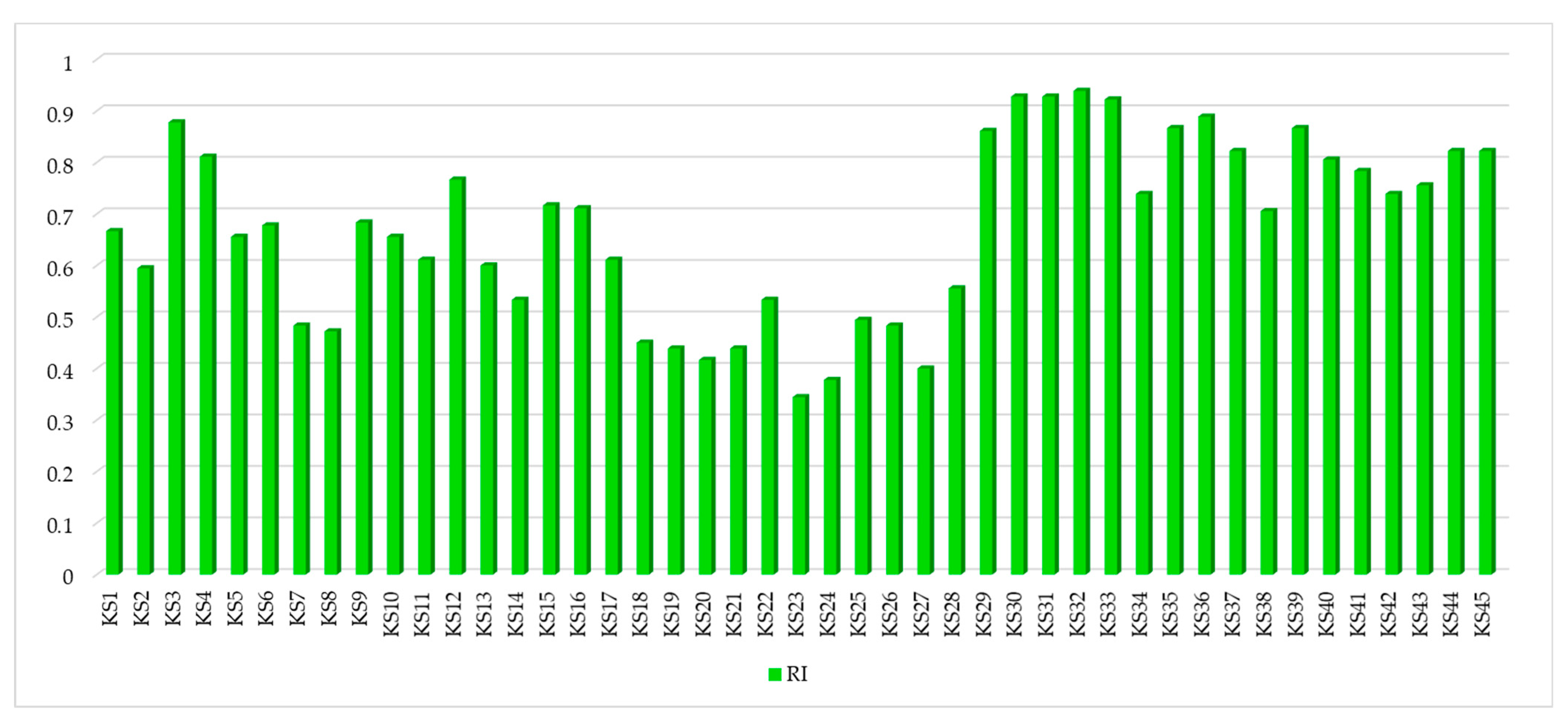
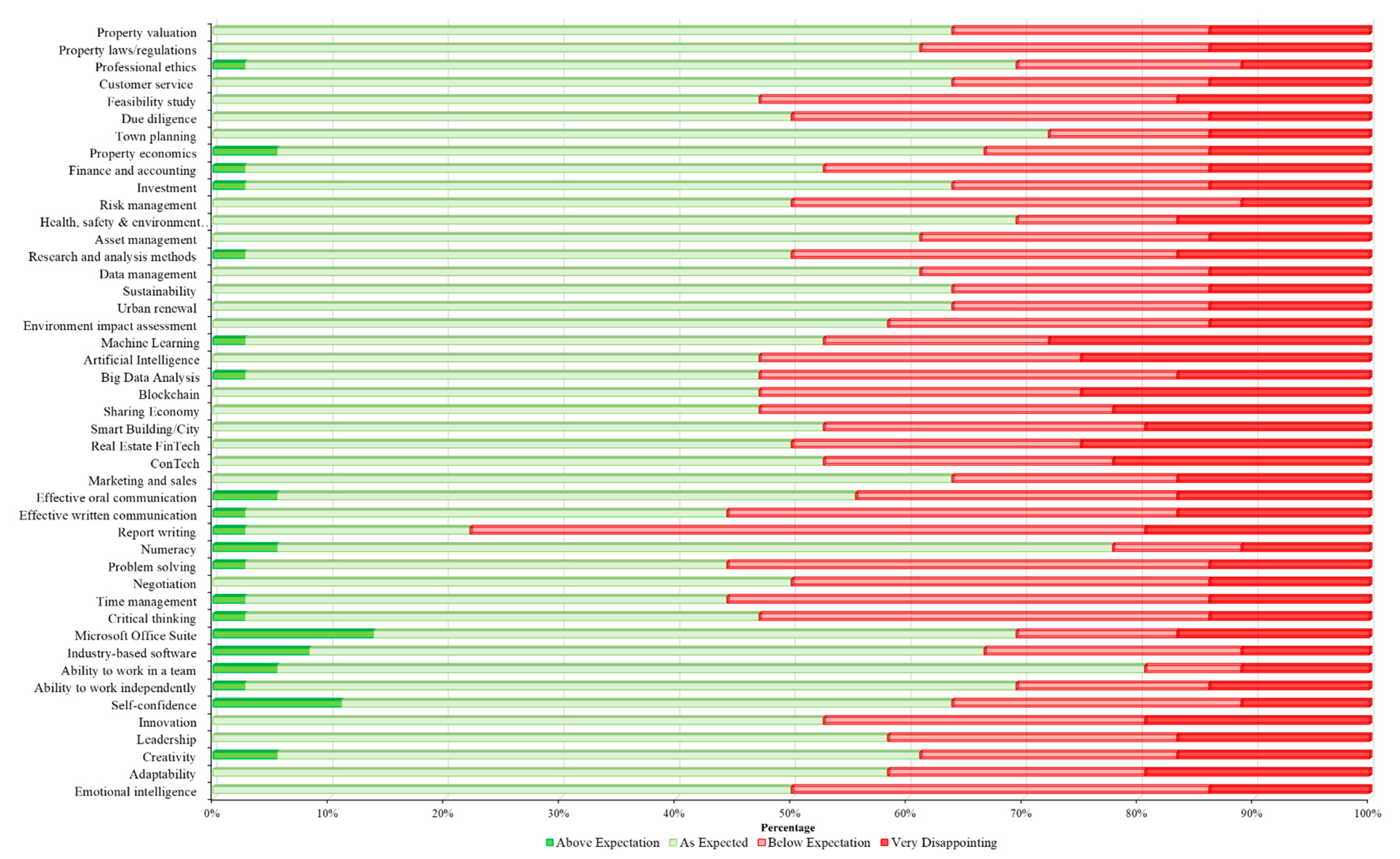
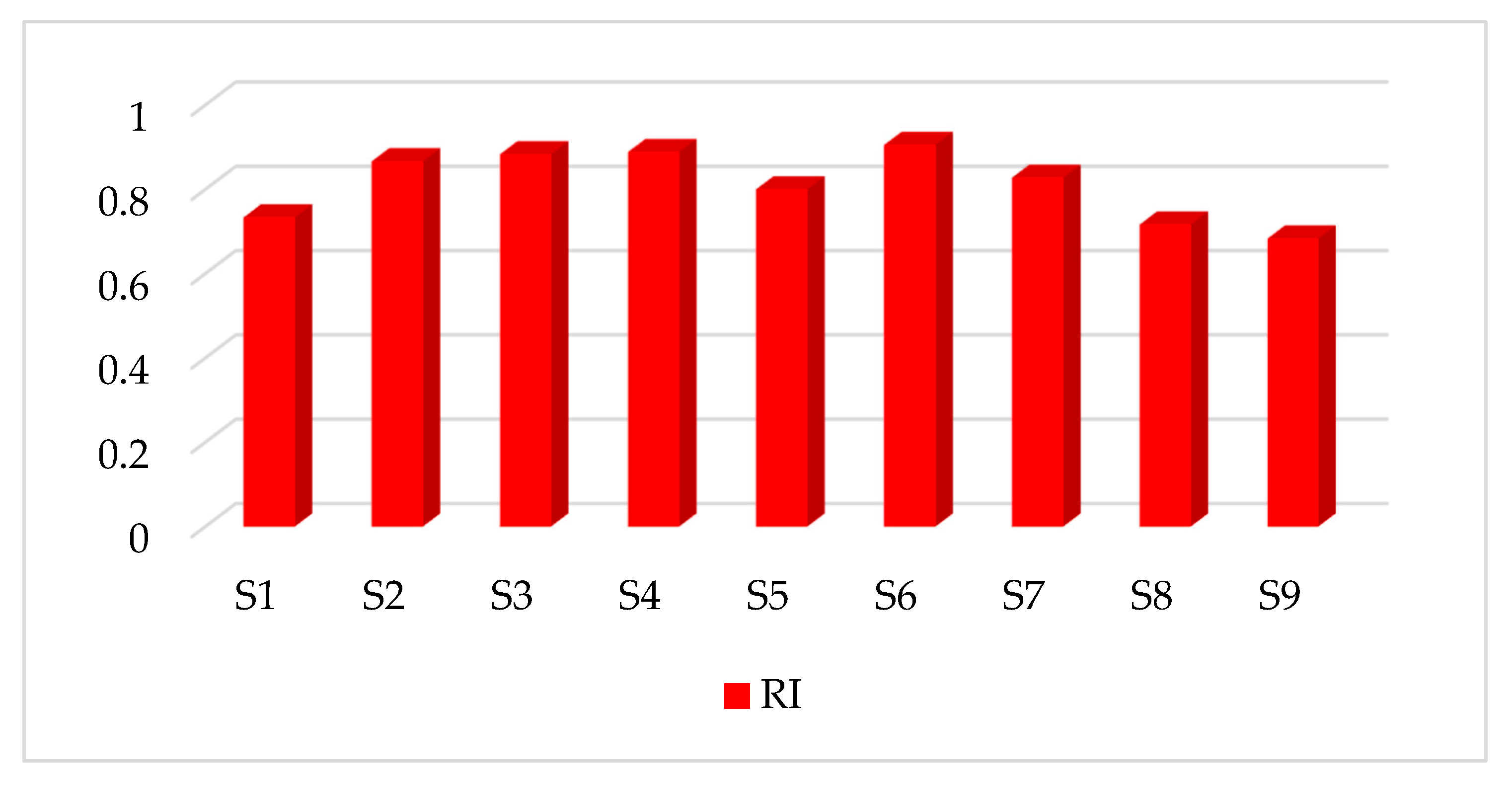

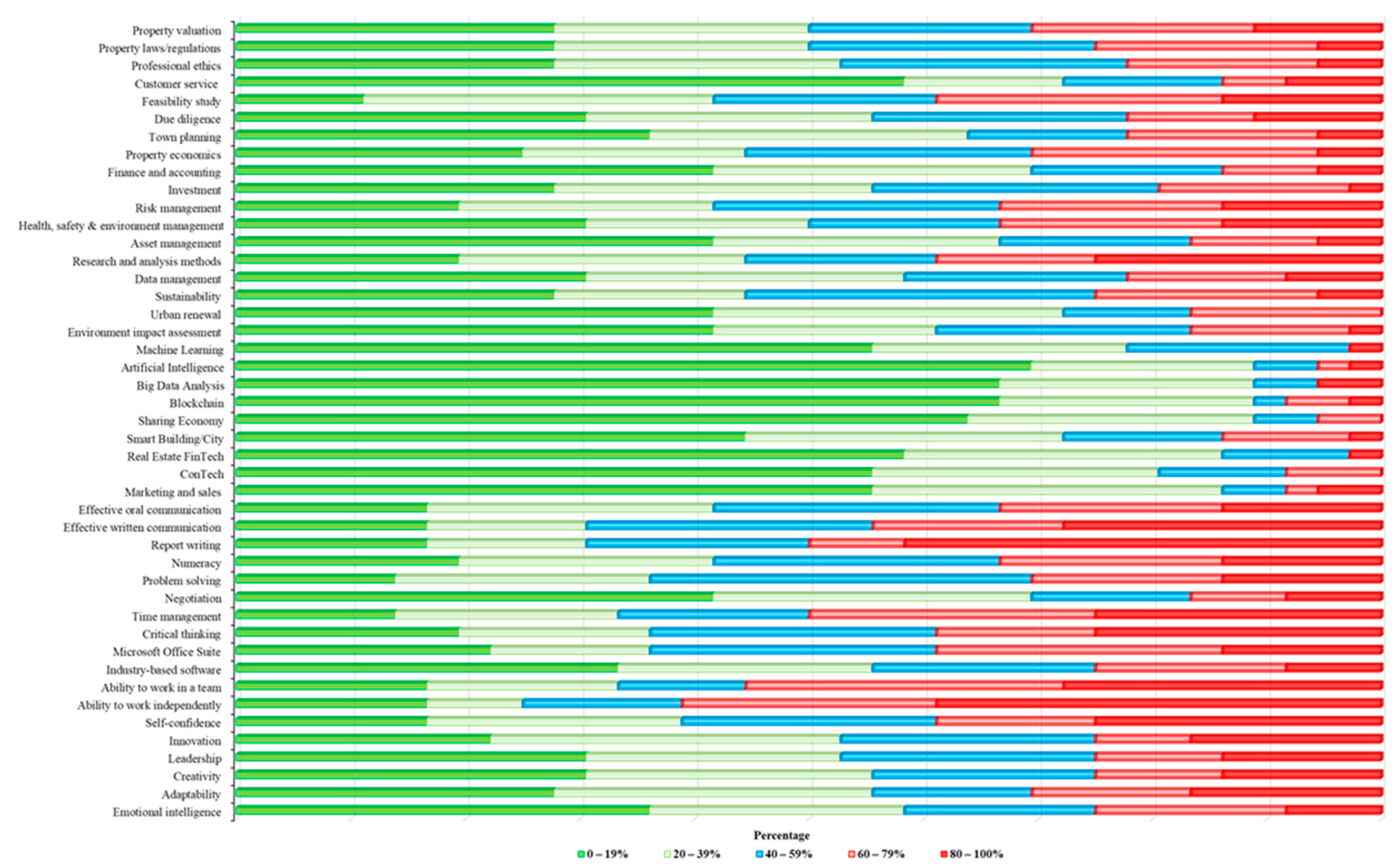
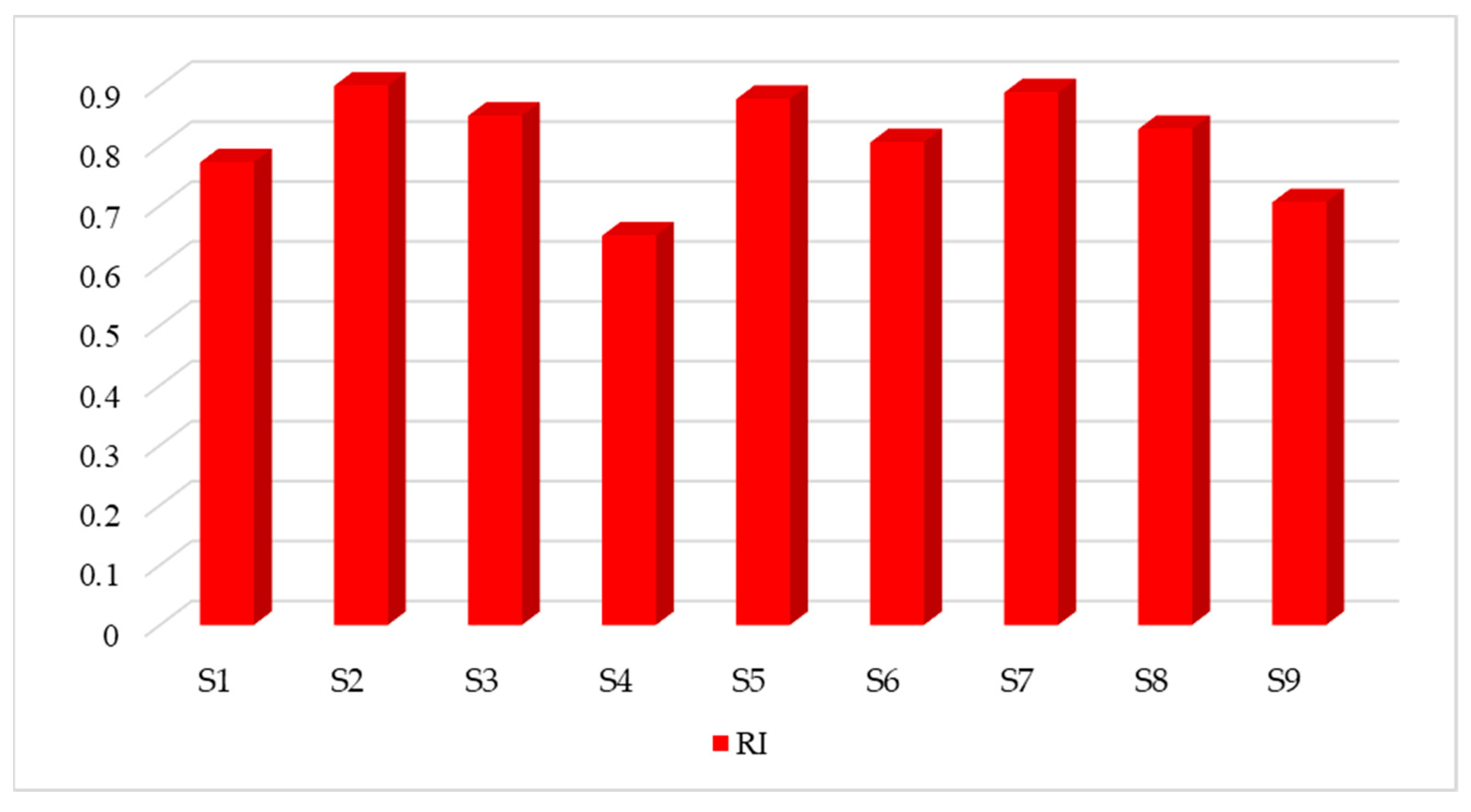
| Item Code | Items | Sources |
|---|---|---|
| KS1 | Property valuation | Newell and Eves [5]; Black and Rabianski [25]; Hoxley, Poon [32]; Poon [33]; Ayodele, Oladokun [31] |
| KS2 | Property laws/regulations | Blake and Susilawati [22]; Blake, Cradduck [34]; Hoxley, Poon [32]; Poon [33]; Ayodele, Oladokun [31] |
| KS3 | Professional ethics | Black and Rabianski [25]; Alao, Pilane [35]; Hoxley, Poon [32]; Ayodele, Oladokun [31], Matsouka and Mihail [36]; Obi, Hampton [37]; Succi and Canovi [27] |
| KS4 | Customer service | Hoxley, Poon [32]; Poon [33]; [14], Succi and Canovi [27] |
| KS5 | Feasibility study | Black and Rabianski [25] |
| KS6 | Due diligence | Gibler, Black [9]; Epley [10]; Manning and Epley [13] |
| KS7 | Town planning | Callanan and McCarthy [19]; Poon [33]; Ayodele, Oladokun [31] |
| KS8 | Property economics | Newell and Eves [5]; Callanan and McCarthy [19]; Hoxley, Poon [32] |
| KS9 | Finance and accounting | Manning and Epley [13]; Hoxley, Poon [32]; Poon [33]; Ayodele, Oladokun [31] |
| KS10 | Investment | Manning and Epley [13]; Poon [33] |
| KS11 | Risk management | Black and Rabianski [25]; Weinstein and Worzala [14]; Hoxley, Poon [32]; Poon [33] |
| KS12 | Health, safety & environment management. | Hoxley, Poon [32]; Poon [33] |
| KS13 | Asset management | Hoxley, Poon [32]; Poon [33] |
| KS14 | Research and analysis methods | Callanan and McCarthy [19]; Epley [10]; Alao, Pilane [35]; Aliu and Aigbavboa [28], Jackson and Chapman [38] Obi, Hampton [37] |
| KS15 | Data management | Hoxley, Poon [32]; Poon [33]; Prikshat, Montague [39] |
| KS16 | Sustainability | Savage [40]; Poon [33]; Gallardo-Vázquez and Folgado-Fernández [41] |
| KS17 | Urban renewal | Savage [40]; Hoxley, Poon [32]; Poon [33] |
| KS18 | Environment impact assessment | Savage [40]; Hoxley, Poon [32]; Poon [33] |
| KS19 | Machine Learning | Pate [42]; Prikshat, Montague [39]; Starr, Saginor [43] |
| KS20 | Artificial Intelligence | Pate [42]; Prikshat, Montague [39]; Starr, Saginor [43] |
| KS21 | Big Data Analysis | Pate [42]; Starr, Saginor [43] |
| KS22 | Blockchain | Baum [44]; Pate [42] |
| KS23 | Sharing Economy | Baum [44] |
| KS24 | Smart Building/City | Baum [44]; Starr, Saginor [43] |
| KS25 | Real Estate FinTech | Baum [44]; Starr, Saginor [43] |
| KS26 | ConTech | Baum [44] |
| KS27 | Marketing and sales | Gibler, Black [9]; Epley [10]; Poon [33]; Matsouka and Mihail [36]; Pate [42] |
| KS28 | Effective oral communication | Weinstein and Worzala [14]; Xiao and Chan [4]; Ayodele, Oladokun [31]; Obi, Hampton [37]; Azmi, Hashim [45]; Succi and Canovi [27] |
| KS29 | Effective written communication | Weinstein and Worzala [14]; Poon [33]; Xiao and Chan [4]; Ayodele, Oladokun [31]; Azmi, Hashim [45]; Succi and Canovi [27] |
| KS30 | Report writing | Callanan and McCarthy [19]; Poon [46]; Xiao and Chan [4] |
| KS31 | Numeracy | Newell and Mallik [47]; Poon [33]; Prikshat, Montague [39]; Obi, Hampton [37] |
| KS32 | Problem solving | Alao, Pilane [35]; Aliu and Aigbavboa [28] |
| KS33 | Negotiation | Black and Rabianski [25]; Poon [33]; Prikshat, Montague [39]; Obi, Hampton [37] |
| KS34 | Time management | Alao, Pilane [35]; Poon [33]; Ayodele, Oladokun [31] |
| KS35 | Critical thinking | Gibler, Black [9]; Weinstein and Worzala [14]; Alao, Pilane [35]; Reid and Anderson [48]; Poon [33] |
| KS36 | Microsoft Office Suite | Alao, Pilane [35]; Azmi, Hashim [45]; Prikshat, Montague [39] |
| KS37 | Industry-based software | Weinstein and Worzala [14]; Poon [33]; Obi, Hampton [37] |
| KS38 | Ability to work in a team | Weinstein and Worzala [14]; Poon [33]; Matsouka and Mihail [36]; Pate [42]; Obi, Hampton [37]; Succi and Canovi [27] |
| KS39 | Ability to work independently | Hoxley, Poon [32]; Poon [33]; Azmi, Hashim [45] |
| KS40 | Self-confidence | Hoxley, Poon [32]; Poon [33]; Azmi, Hashim [45] |
| KS41 | Innovation | Hoxley, Poon [32]; Matsouka and Mihail [36]; Azmi, Hashim [45]; Succi and Canovi [27] |
| KS42 | Leadership | Weinstein and Worzala [14]; Alao, Pilane [35]; Ahn, Annie [49]; Ayodele, Oladokun [31]; Obi, Hampton [37] |
| KS43 | Creativity | Hoxley, Poon [32]; Matsouka and Mihail [36]; Azmi, Hashim [45]; Pate [42]; Obi, Hampton [37]; Succi and Canovi [27] |
| KS44 | Adaptability | Alao, Pilane [35]; Matsouka and Mihail [36], Azmi, Hashim [45]; Succi and Canovi [27]; Pate [42]; Aliu and Aigbavboa [28] |
| KS45 | Emotional intelligence | Matsouka and Mihail [36]; Pate [42]; Obi, Hampton [37] |
| Initiatives for Bridging the Expectation Gaps | ||
| S1 | On-the-job training after graduation | Ndong de Souza [50] |
| S2 | Overhauling of university’s curriculum | Poon [33], Odubiyi, Aghimien [51] |
| S3 | Encouraging students to join professional organisations | Poon [33] |
| S4 | Course directors maintaining close communication with employers | Poon [33] |
| S5 | Using various course delivery methods such as simulation | Avramenko [52], Poon [33] |
| S6 | School assessment should be based on real-life case studies | Wong, Wong [53] |
| S7 | Industry practitioners guest lecture presentation to students | Callanan and McCarthy [19], Odubiyi, Aghimien [51] |
| S8 | Compulsory internship training while studying | Callanan and McCarthy [19] |
| S9 | Attending CPD as students | Scheurwater [54], Hoxley, Poon [32], Succi and Canovi [27] |
| Variables | Frequency (n = 36) | Percentage |
|---|---|---|
| Age | ||
| 25 and below | 0 | 0.0 |
| 26–30 | 1 | 2.8 |
| 31–35 | 4 | 11.1 |
| 36–40 | 8 | 22.2 |
| 41–45 | 4 | 11.1 |
| 46–50 | 4 | 11.1 |
| 51–55 | 3 | 8.3 |
| 56 and above | 12 | 33.3 |
| Gender | ||
| Male | 31 | 86.1 |
| Female | 5 | 13.9 |
| Industry experience | ||
| 0–5 years | 0 | 0.0 |
| 6–10 years | 1 | 2.8 |
| 11–15 years | 6 | 16.7 |
| 16–20 years | 9 | 25.0 |
| Above 20 years | 20 | 55.6 |
| Education qualification | ||
| Diploma | 1 | 2.8 |
| Bachelor | 22 | 61.1 |
| Master | 10 | 27.8 |
| PhD | 0 | 0.0 |
| Others | 3 | 8.3 |
| Property graduates hired each year | ||
| 1–10 | 3 | 8.3 |
| 11–50 | 25 | 69.4 |
| 51–100 | 7 | 19.4 |
| Above 100 | 1 | 2.8 |
| Property specialisations * | ||
| Property consultancy and analysis | 16 | 22.2 |
| Property valuation | 14 | 19.4 |
| Asset/facility management | 11 | 15.2 |
| Property development | 6 | 8.3 |
| Property sales, leasing and management | 4 | 5.6 |
| Others | 21 | 29.1 |
| Variables | Frequency (n = 36) | Percentage |
|---|---|---|
| Educational qualification | ||
| Undergraduate | 22 | 61.1 |
| Postgraduate | 14 | 38.9 |
| Age | ||
| 20–25 | 13 | 36.1 |
| 26–30 | 14 | 38.9 |
| 31–35 | 8 | 22.2 |
| Above 35 | 1 | 2.8 |
| Gender | ||
| Male | 25 | 69.4 |
| Female | 11 | 30.6 |
| Industry experience | ||
| 1 year | 8 | 22.2 |
| 2 years | 4 | 11.1 |
| 3 years | 7 | 19.4 |
| 4 years | 2 | 5.6 |
| 5 years | 1 | 2.8 |
| Above 5 years | 14 | 38.9 |
| Property specialisations * | ||
| Construction project management | 15 | 27.8 |
| Property development | 7 | 13.0 |
| Construction | 6 | 11.1 |
| Contract management | 6 | 11.1 |
| Property consultancy and analysis | 5 | 9.3 |
| Others | 15 | 27.8 |
| Item Code | Employers | Graduates | ||
|---|---|---|---|---|
| Mean Rank | MWU Test | Significance | ||
| KS3 | 43.86 | 29.14 | 383.000 | 0.002 |
| KS6 | 30.68 | 42.32 | 438.500 | 0.014 |
| KS8 | 31.06 | 41.94 | 452.000 | 0.023 |
| KS11 | 28.28 | 44.72 | 352.000 | 0.001 |
| KS16 | 42.17 | 30.83 | 444.000 | 0.017 |
| KS22 | 43.53 | 29.47 | 395.000 | 0.003 |
| KS24 | 31.36 | 41.64 | 463.000 | 0.030 |
| KS27 | 30.99 | 42.01 | 449.500 | 0.019 |
| KS28 | 24.50 | 48.50 | 216.000 | 0.000 |
| KS30 | 42.21 | 30.79 | 442.500 | 0.009 |
| KS31 | 44.17 | 27.60 | 336.000 | 0.000 |
| KS34 | 28.39 | 44.61 | 356.000 | 0.000 |
| KS38 | 27.47 | 45.53 | 323.000 | 0.000 |
| KS40 | 30.03 | 42.97 | 415.000 | 0.004 |
| KS42 | 31.85 | 41.15 | 480.500 | 0.047 |
| Item Code | Employers | Graduates | ||
|---|---|---|---|---|
| Mean Rank | MWU Test | Significance | ||
| S4 | 43.61 | 29.39 | 392.000 | 0.002 |
| S5 | 29.81 | 43.19 | 407.000 | 0.003 |
| S6 | 41.54 | 31.46 | 466.500 | 0.025 |
| S7 | 32.07 | 40.93 | 488.500 | 0.049 |
| S8 | 29.67 | 43.33 | 402.000 | 0.004 |
Publisher’s Note: MDPI stays neutral with regard to jurisdictional claims in published maps and institutional affiliations. |
© 2022 by the authors. Licensee MDPI, Basel, Switzerland. This article is an open access article distributed under the terms and conditions of the Creative Commons Attribution (CC BY) license (https://creativecommons.org/licenses/by/4.0/).
Share and Cite
Abidoye, R.; Lim, B.T.H.; Lin, Y.-C.; Ma, J. Equipping Property Graduates for the Digital Age. Sustainability 2022, 14, 640. https://doi.org/10.3390/su14020640
Abidoye R, Lim BTH, Lin Y-C, Ma J. Equipping Property Graduates for the Digital Age. Sustainability. 2022; 14(2):640. https://doi.org/10.3390/su14020640
Chicago/Turabian StyleAbidoye, Rotimi, Benson Teck Heng Lim, Yu-Cheng Lin, and Junge Ma. 2022. "Equipping Property Graduates for the Digital Age" Sustainability 14, no. 2: 640. https://doi.org/10.3390/su14020640
APA StyleAbidoye, R., Lim, B. T. H., Lin, Y.-C., & Ma, J. (2022). Equipping Property Graduates for the Digital Age. Sustainability, 14(2), 640. https://doi.org/10.3390/su14020640








